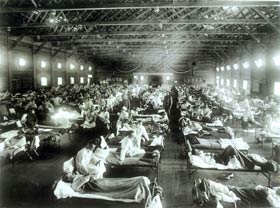Detecting 1918 virus secret weapon
Scientists have successfully reproduced the killing process of the H1N1 virus and the 1918 Spanish flu virus. The flu has claimed more than 50 million lives. With this finding, scientists believe they have added a weapon to fight the H5N1 virus if it spreads from person to person.
 (Photo: Nationalgeographic) In the monkey experiment, Canadian scientists found that the lungs of this animal were quickly destroyed by the H1N1 virus after a few days. Experiments on the mouse also showed similar results.
(Photo: Nationalgeographic) In the monkey experiment, Canadian scientists found that the lungs of this animal were quickly destroyed by the H1N1 virus after a few days. Experiments on the mouse also showed similar results.
Scientists have discovered that the H1N1 virus has blocked the protein produced by the RIG - 1 gene (a protein that heals wounds in infected tissues). Experiments show that the concentration of this protein in monkeys infected with H1N1 virus is lower than normal. This makes the monkey's immune system confused and out of control.
Professor Yoshihiro Kawaoka, the head of the program, said he obtained similar results between monkeys infected with H1N1 and monkeys infected with the H5N1 virus.
This is the first time scientists understand the mechanism of the H1N1 virus. Although up to 50 million people died from the virus, scientists did not have the virus. Recently thanks to genetic engineering, scientists have created the H1N1 virus.
DKKL
- Discovering 'secret weapon' in female reproductive organs can fight HIV
- The supposedly useless immune cells are actually weapons against HIV
- Russia warned of the risk of Ebola as a biological weapon
- The United States created a weapon that produced a voice that terrified the enemy
- Revealing 'secret weapon' to hunt NASA's new planet
- The ultra-powerful weapons are 'covered' by the beautiful shell
- Detecting a virus can cure cancer effectively
- Is the 'secret weapon' causing Havana syndrome a mosquito killer?
- Detecting 7 more carcinogens
- Detecting Ebola virus in spermatozoa who got sick 9 months earlier
- Process of Zika virus testing in Vietnam
- Secret secret weapon used to assassinate during World War 2
 Green tea cleans teeth better than mouthwash?
Green tea cleans teeth better than mouthwash? Death kiss: This is why you should not let anyone kiss your baby's lips
Death kiss: This is why you should not let anyone kiss your baby's lips What is salmonellosis?
What is salmonellosis? Caution should be exercised when using aloe vera through eating and drinking
Caution should be exercised when using aloe vera through eating and drinking